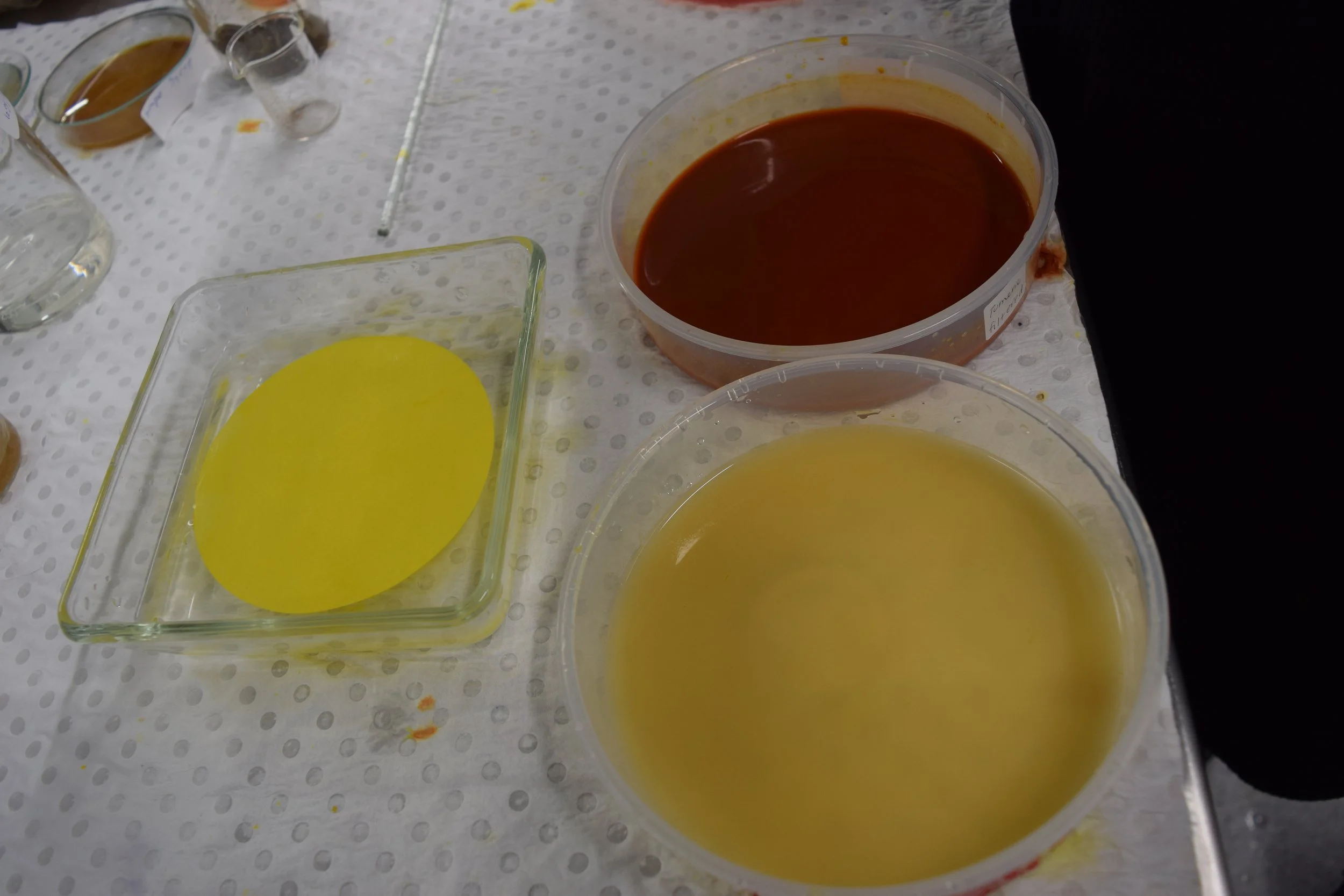TURMERIC (ZARD-CHUBEH) DYE RECIPES
In Persian historical treatises, a single technique is described for obtaining turmeric dye to color paper. The process involves using ground turmeric mixed with alkaline ash, known as ašḵār, and boiling it with water. Lemon juice is added to the dye-bath during the dyeing process to enhance the fastness of the dye. The alkaline ash, ašḵār, is derived from burning a plant called ošnān in Persian. Biruni (440 A.H./1048 A.D.) has referred to it as the substance obtained from the extract of the ashes of Salsola Kali L., containing sodium and potassium carbonate.
The only sources describing this technique are Resāleh-ye Dar Bayān-e Rang Kardan-e Kāğaḏ in the 19th century and Resāleh-ye Ḵošnevīsī (1120 A.H./1708 A.D.) in the 18th century.
نیم آسار زرد چوبه که نیک زرد باشد. و از اندرون سیاه نه برآید، جوکوب کرده در دیگ با پنج آسار آب تخمیناً بکند و بر آتش پاره کرده جوش چند داده از لتّه بگذراند، و صاف کند و قدری اشخار، خوب صلایه کرده و از لتّه گذرانده در آب زردچوبه صاف کرده، بیندازد و به دست بپالاید تا رنگ وا دهد. بعد از آن در ظرف گشاده که کاغذ شکست نخورد و نگاه دارد. و دیگر آب لیمو از لتّه گذرانده در همانطور ظرف گشاده، که مذکور شد، علیحده نگاه دارد، و در یک ظرف علیحده سر گشاده، دیگر آب صاف پر کرده، نزد خود نگاه دارد
صورت رنگ کردن کاغذ: کاغذ را اوّل مرتبه در ظرف آب زردچوبه بنوعی بخواباند که رنگ در همه جای او برسد و گر می خواسته باشد که تیره تر شود دو سه مرتبه در میان زرد آب غوطه دهد و ملاحظه نماید که اگر خاطرخواه براید فهوالمراد، والّا باز ساعتی در آب مذکور بگذارد، و اگر می خواسته باشد کم رنگ و بی حال باشد، آب بیندازد و تجربه نماید تا مدّعا حاصل شود. بعد از آن کاغذ از میان زرد آب بدر آورد در شیرهٔ آب لیمو بجنباند که همه جای او برسد، بعد از آن از آنجا بدر آورد. در ظرف آب صاف شست و شوی بدهد و در سایه خشک کند
Take half a istar[1] of pure yellow turmeric and grind it coarsely. Then place it in a big pot. Add nearly 5 istars of water and bring it to a boil. Filter it through a piece of muslin cloth. Then take some alkaline ash (ašḵār) and grind it. Pass it through a piece of muslin cloth and add it to the filtered turmeric water. Hand-mix the mixture and pour it into an open-mouthed vessel, so that the paper does not tear and fold. Take two other flat bowls and pour filtered water into one and filtered lemon juice into another. First, dip the paper in the turmeric water thoroughly. If a deep yellow is required, repeat the process as many times as needed until the desired color is obtained. If a light yellow is required, add more water until you get the right color. After that, take out the paper from the turmeric dye, dip it in the lemon juice, and agitate well until it fully penetrates the paper. Take out the paper from the lemon juice, dip it in the water vessel, and wash it thoroughly. Take it out and let it dry in the shade.
[1] istar is equivalent to 4 1⁄2 methqāl, each methqāl being equal to 4.46 grams.
Experiment:
Take 20g of turmeric roots or turmeric powder and grind them using a pestle and mortar. Transfer the ground turmeric to a glass jar and add 200 ml of water, bringing it to a boil. Stir the mixture and filter it to extract the turmeric dye. Grind 1g of alkaline ash, dilute it with lukewarm water, and filter the alkaline solution. Add the alkaline solution to the filtered turmeric dye, stir the mixture, and pour it into a tray. Prepare two other trays, one with filtered water and the other with filtered lemon juice. Dip the paper into the turmeric and ash dye bath. For a deep yellow, repeat the process as needed. For a lighter shade, add more water. Afterward, dip the paper in lemon juice, agitate well, then dip it in water and wash thoroughly. Finally, take it out and let it dry in the shade.







